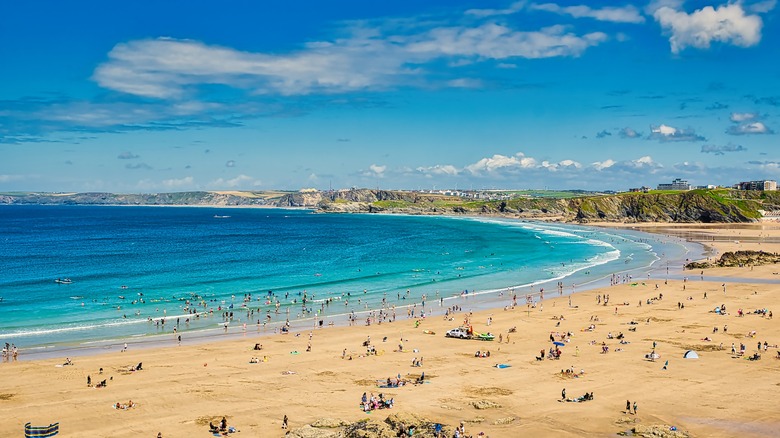Perched on Cornwall’s rugged Atlantic Coast, Newquay — often dubbed the “Surf Capital of the United Kingdom” — is a vibrant seaside town with dramatic cliffs, golden beaches lapped by rolling waves, and an impressive collection of outdoor and cultural attractions: From view-laden hikes and elegant gardens to historic cottages and dolphin-spotting boat trips. Better yet, the beaches are, along with those in Devon, some of the top-ranked on the UK coastline — with rustic stretches of sand perfect for all types of activities, from surfing and kite surfing to paddleboarding and sea kayaking.
The town is wonderfully walkable, whether ambling along the scenic waterfront or wading through its charming streets in search of independent shops, cozy cafes, and seafood restaurants. For anyone craving more active adventures, the South West Coast Path offers exceptional coastal hikes revealing expansive panoramas of the Atlantic.
The closest major international airport is London Heathrow, approximately 241 miles away. However, there’s also a local airport, the Cornwall Airport Newquay, which offers a limited selection of flights connecting to national and European destinations — including Manchester, one of the UK’s most underrated cities, and Edinburgh, the Scottish capital. That said, the best way to reach Newquay is traveling via direct train from London Paddington, a journey of around five hours. Another rail option is to board one of the UK’s very few sleeper trains, the Night Riviera Sleeper, which departs from London’s Paddington Station just before midnight and arrives in Newquay the next morning via a connecting train from Par station.
The best beaches for surfing in Newquay
Newquay’s best-known beach is the southwest facing Fistral — a busy stretch of sand that’s become the home of surfing in Cornwall due to its dependable waves and Atlantic swells. It’s a good spot for all skill levels, the only caveat being that it’s one of the busiest beaches in Europe. For skilled surfers, there’s a big surf wave here: the Cribbar, which breaks over a reef and, when the weather and swell are just right, creates an immense 30-foot-high wall of water. Visit Fistral Beach on a summer evening and you’ll find a convivial atmosphere, with the local beach bars filled with sunset hunters mingling with local surfers.
An issue that arises from the U.K.’s changeable weather is that southwest-facing beaches can be too exposed to high winds and swell. That’s when locals head toward Newquay Bay — a collection of beaches mostly sheltered from the southwest winds. The most sheltered of the beaches is Towan Beach, which lends itself well to beginners and those looking for a gentler surf. Meanwhile, beaches like Tolcarne are a little more exposed to the headland swells.
Around 3 miles north of Newquay, you’ll find a gorgeous stretch of pale golden sands called Watergate Beach. At low tide, the beach appears huge — 2 miles of natural sands beautifully framed by Trevelgue Head cliffs and Stem Point. A west-facing beach generally preferred by intermediate and advanced surfers, it’s also particularly popular with locals. It’s a nice beach for nature lovers too, with craggy inlets and coves where you’ll see starfish and crabs mingling in the rock pools.



